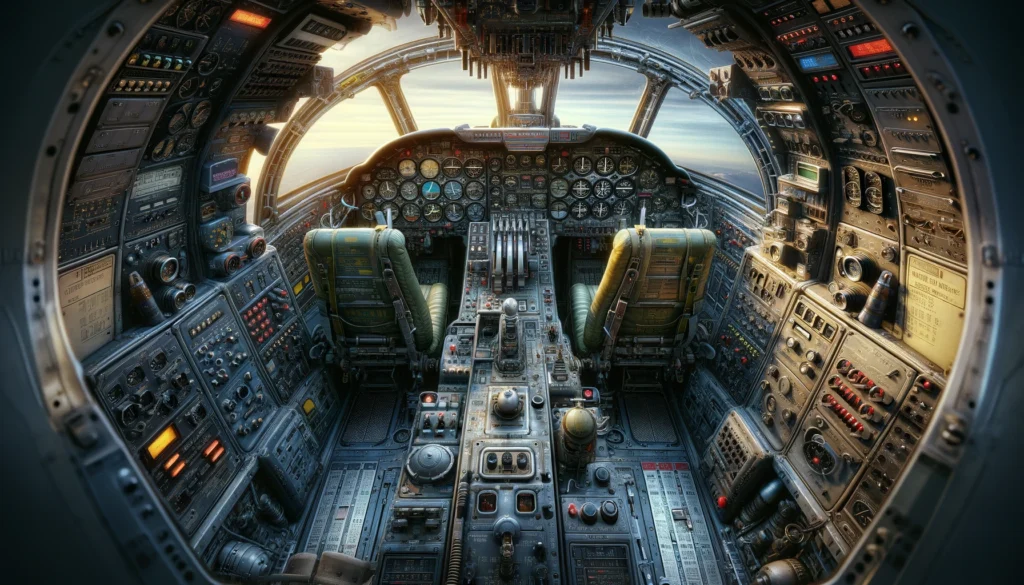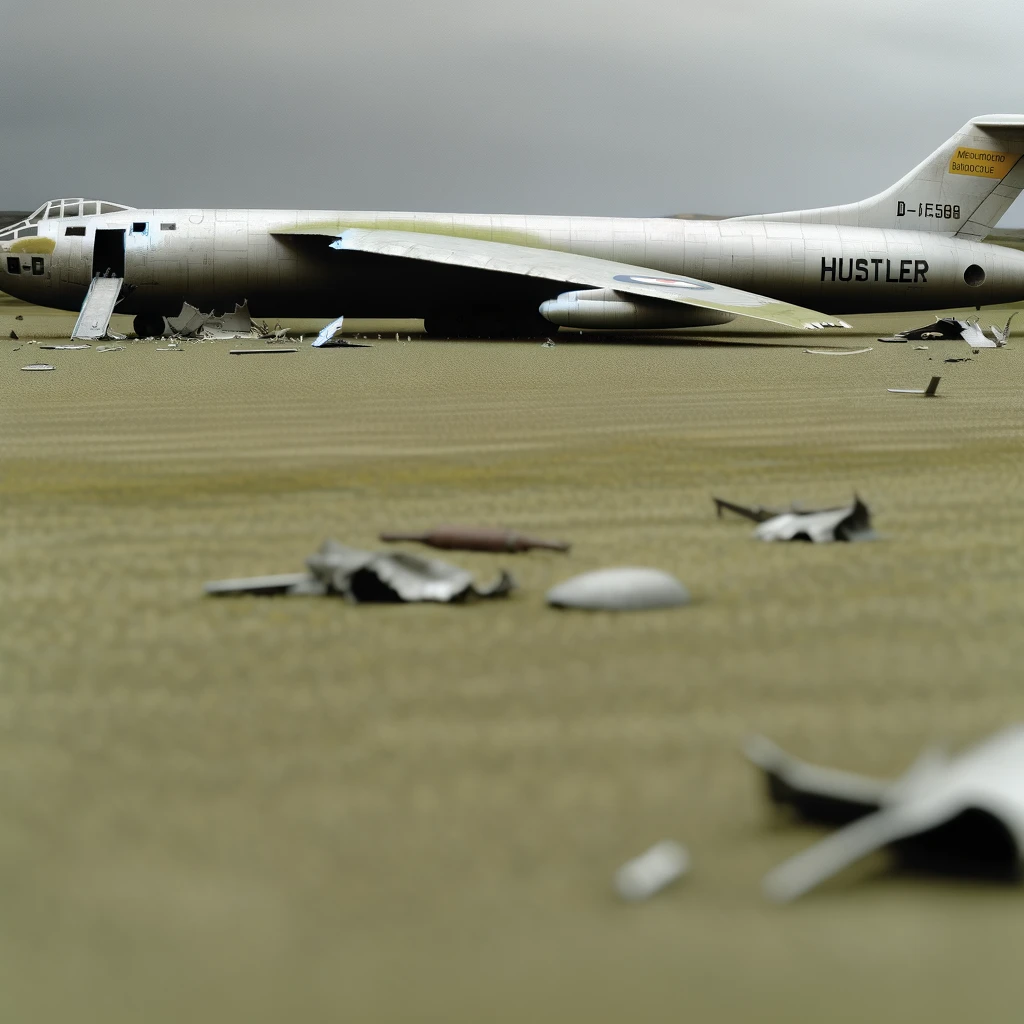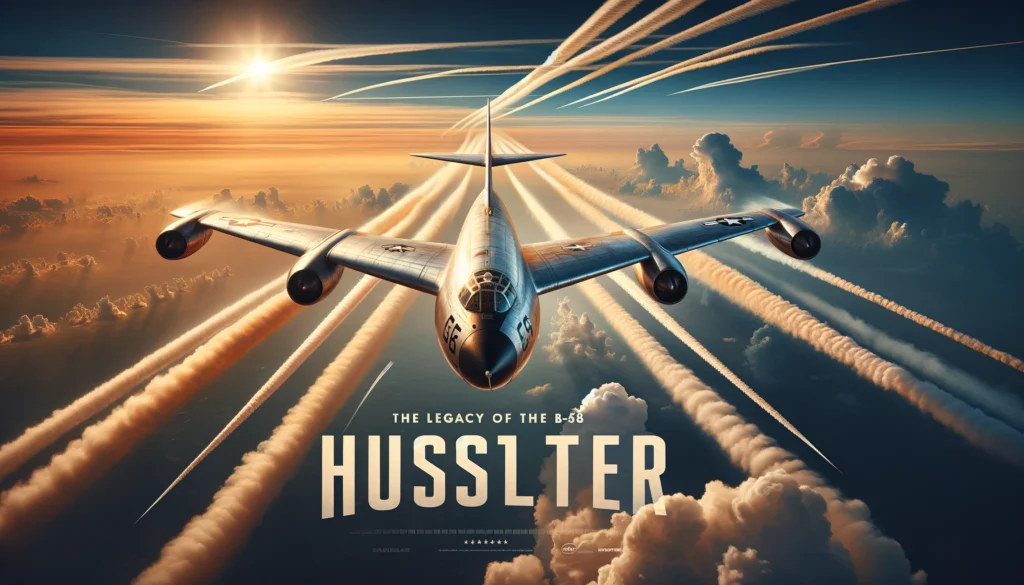The Convair B-58 Hustler is fantastic proof of the high-level invention skills and courageousness of aviation technology during the Cold War. The first operational supersonic bomber capable of Mach 2 speed was the B-58.
Hustler was not only proof of an engineering feat, but it was also a loud reminder of the USA being the air superiority holder during times of escalated global competition.
Its unique Delta wing design, powerful J79 engines, as well as its strategic role as a high-altitude bomber made the B-58 Hustler stand out from anything else flying in the ’60s – ’70s era.
Moreover, this article is about the specifications, features, history, and everything you want to know about the B 58 aircraft, focusing on its cutting-edge design, historic accomplishments, crashes/incidents, the List of B-58 Surviving aircraft, and the issues it had all along.
Let’s take a look at some of the Hustler’s key specifications and features:
B 58 Weight Capacity:
The B-58 could lift off at a maximum takeoff weight of 163,000 pounds, which makes it capable of carrying heaving payloads over long distances.
B 58 Fuel Capacity:
With a fuel system built for long-range operations, the B-58 could carry up to 15,000 gallons of fuel.
B 58 Range:
Additionally, The Hustler was capable of covering around 4400 miles without taking aerial refueling.
B 58 Models:
The first official model was the B-58A, but before that two prototype models XB-58 were built, and then 11 other subtypes YB-58A were developed for training and reconnaissance purposes.
| Model | Important Details |
| XB-58 | Prototype; two built. |
| YB-58A | Pre-production aircraft; 11 built. |
| B-58A | Three-seat medium-range strategic bomber aircraft; 86 built. |
| TB-58A | Training aircraft, eight conversions from YB-58A. |
| NB-58A | was Used to test the GE J93 engine for the XB-70 Valkyrie; a converted YB-58A. |
| RB-58A | Reconnaissance variant with ventral pod; 17 built. |
| B-58B | Unbuilt. Envisioned with uprated engines, longer fuselage, canards, and conventional weapons capability. The project was canceled before construction began. |
| B-58C | Unbuilt. Proposed Mach 3 variant with J58 engines and enhanced range. Canceled due to evolving enemy defenses. |
| B-58D | Unbuilt. Proposed interceptor variant taking advantage of its speed and altitude capabilities. |
| B-58E | Unbuilt. Proposed multi-mission platform armed with ALBMs. |
| Convair 58-9 | Proposed supersonic transport intended for carrying 58 passengers at speeds exceeding Mach 2; part of the National Supersonic Transport program bid. |
B 58 Crew Stations:
B-58 design incorporated a novel crew station consisting of three ejection capsules for the pilot, navigator/bombardier, and defensive systems operator.
B 58 Top Speed:
The plane with a maximum speed of supersonic Mach 2, or over 1,319 mph at high altitudes.
B 58 Weapons Pod:
Moreover, the B-58 was armed with an advanced weapons pod capable of carrying Nuclear & Conventional Bombs.
Highlighted Features of the B-58 Hustler
| Specification | Detail | Unique Comparison or Insight |
| Crew | 3 | As synergized as the Three Musketeers. |
| Length | 96 ft 10 in (29.51 m) | Longer than a blue whale. |
| Wingspan | 56 ft 9 in (17.30 m) | Spans nearly the width of an NBA court. |
| Height | 29 ft 11 in (9.12 m) | Height of a three-story building in stature. |
| Wing Area | 1,542 sq ft (143.3 m^2) | Comparable to six ping-pong tables. |
| Aspect Ratio | 2.09 | Highlighting its sleek design. |
| Airfoil | NACA 0003.46 (root), NACA 0004.08 (tip) | Crafted for aerodynamic supremacy. |
| Empty Weight | 55,560 lb (25,202 kg) | Weighs as much as 10 adult elephants. |
| Gross Weight | 67,871 lb (30,786 kg) | Surpasses the heft of a fully loaded semi-truck. |
| Max Takeoff Weight | 176,890 lb (80,236 kg) | Equals the weight of 40 pickup trucks. |
| Powerplant | 4 × GE J79-GE-5A turbojets | Each engine’s thrust outmatches 200 sports cars. |
| Max Speed | Mach 2.0 (1,319 mph, 2,122 km/h) | Outspeeds the Peregrine falcon, the fastest bird. |
| Cruise Speed | 610 mph (980 km/h) | Faster than the bullet train’s sprint. |
| Range | 4,700 mi (7,600 km) | Can cross the Atlantic without refueling. |
| Combat Range | 2,000 mi (3,220 km) | Like flying from New York to Denver and back. |
| Service Ceiling | 63,400 ft (19,300 m) | Higher than the summit of Mount Everest. |
| Rate of Climb | 17,400 ft/min (88 m/s) | Ascends quicker than a launching rocket. |
| maximum weapons load | Various, up to 19,450 Pounds | Equipped for versatile mission capabilities. |
| Armaments | 1× 20 mm cannon, and B61 Nuclear bombs | Ensure air supremacy with formidable firepower. |
Innovation and Legacy of the B-58 Hustler:
- Pioneering Supersonic Speeds: Besides all, the B-58 Hustler was the pioneer that carried the title of the world’s first operational supersonic jet bomber, showing how far ahead in technology aviation was.
Learn about the Fastest Aircraft in the World.
- Breaking Barriers: On top of this, it set the record-breaking speed of Mach 2, which has become a benchmark of strategic aerospace defense during the so-called “Cold War.”
Main Operations problems of B-58:
- Maintenance Hurdles: Moreover, Considering its effectiveness, the B-58’s maintenance, which is quite high, is attributed to the elevated operational costs.
- Crew Complications: This sophisticated technology and taxing flight feature took a lot of work to learn for the aircrews, so there was a lot of delay in mission accomplishment as a result.
The Historical Legacy of the B-58:
- Cold War Aviation: B-58 in the history of the Cold War was very important, providing both defensive strategies and the design of the supersonic aircraft of the future.
- Design Influence: Due to this delta-wing design and high-altitude performance, it became a significant new step in the field of aviation and the prototype for following supersonic military aircraft.
B-58 Hustler Cockpit (Advanced Features, Flaws & Challenges)
B-58 Cockpit Advanced Features:
1. Ejection Pod System: Additionally, the most cutting-edge element of the B-58’s cockpit was its encapsulated ejection seat system. Moreover, In the case of an emergent situation, the crew compartment with the crew could be ejected, which saves the crew from bailing out at high altitudes or speeds. The safety feature being introduced was indeed revolutionary.

2. Sophisticated Navigation and Bombing Systems: The cockpit was allocated with the latest in electronic navigation and bombing systems, i.e., the AN/ASQ-42. Moreover, This multi-purpose system achieved the integration of pathfinding, bombing, and terrain avoidance functionalities into a single package, making the low-altitude, high-speed flight paths unimaginable.
3. Advanced Flight Controls: The Hustler’s controls were top-notch, being at the cutting edge and designed for precision that exceeded anything seen before. Additionally, The aircraft was equipped with a sophisticated autopilot, which gave it the capability of flying stably at twice the speed of sound. That is an essential aspect of those high-speed and long-distance missions the B-58 was designed for.
B 58 Cockpit Flaws & Challenges:
1. Complexity: Thus, complexity was added to the features. The cockpit was densely stuffed with an abundant variety of controls and systems to handle, especially when under pressure due to the depressing conditions of flight. It added to the need for lengthy and extensive training and could have led to human error.
2. Maintenance Issues: The superior architectures, especially the ejection capsule, required frequent service. Additionally, the situation with the invention being complex and of the latest technology often turned out to be unreliable and added complications in maintenance from the ground crews.
3. Limited Upgrades: With the advancing technology, the 1960s cockpit, installed initially for superior flight performance, became incompatible with new improvements. However, the strict design, which made it impossible to update aircraft with modern avionics and navigation systems, gave in to the aircraft obsolescence.
B-58 crashes & incidents:
| Date | Location | Summary | Casualties |
| Oct 27, 1959 | Near Lake Serene, MS | While flying from Carswell AFB to Eglin AFB, a B-58 developed problems at 25,000 feet, leading to crew ejection. Two landed safely; one fatality. | 1 fatality |
| Apr 22, 1960 | Great Salt Lake, UT | A B-58 crashed into the Great Salt Lake; only the Defense Systems Officer (DSO) survived. | 2 fatalities |
| Jun 3, 1961 | Near Paris Air Show | B-58A Firefly crashed near the Paris Air Show, killing all three onboard. The aircraft had set a transatlantic speed record 8 days earlier. | 3 fatalities |
| Sep 1961 | Edwards AFB, CA | During a training flight, a B-58 suffered a fire and a landing gear failure but made a successful emergency landing after multiple aerial refueling sessions. | No casualties |
| Dec 8, 1964 | Bunker Hill AFB, IN | A B-58 slid off an icy runway and caught fire during a training drill, causing radioactive contamination due to the onboard nuclear weapons. | No fatalities |
| Jun 15, 1965 | Paris Air Show | A B-58 crashed at the Paris Air Show, landing short of the runway and bursting into flames. | 1 fatality, 2 injured |
| Jul 22, 1965 | Unspecified location | B-58 #60-1128 departed runway during landing and was destroyed. | No casualties |
| Dec 12, 1966 | Near McKinney, KY | A B-58 crashed in a field, killing all three crew members. | 3 fatalities |
| Jun 14, 1967 | Unspecified location | B-58 #60-1128 departed the runway during landing and was destroyed. | 1 fatality |
| Apr 3, 1969 | Near Rokeby, NE | The aircraft crashed after its left wing was torn off. All three crew members ejected and survived. | No casualties |
| Apr 18, 1969 | Near Danville, IL | B-58A #61-2056 crashed in a field; all three occupants ejected and survived. | No casualties |
Are there any B-58 still flying?
Unlike before, the B-58 Hustler no longer performs its duty in the present world. On May 27, 1976, the last operational flight of this remarkable aircraft took off as the end of the B-58 supersonic bomber for the United States Air Force.
Known for its delta wing and four turbojet engines, the B-58 thus made its place in the pages of history by achieving outstanding speed records and by revealing the USAF’s strategic bombing capabilities at the time of tense global politics.
Overall, this decision was greatly affected by several factors that determined the fiscal and practical feasibility of maintaining this advanced machinery for its time. Also, the constant evolution of military strategy, which increasingly looked at flexibility and cost-effectiveness, was a contributor to the eventual development of more modern and more efficient aircraft designs.
Along with the appearance of intercontinental ballistic missiles (ICBMs), the transition was accompanied by the end of such bombers as the B-58.
Moreover, Nowadays, the B-58 Hustler legacy continues to be kept alive by the aviation museums in the United States, where enthusiasts and historians can enjoy the outstanding technology and historical value of this plane.
Although we no longer have a B-58 piercing through the clouds, the stories that surround the aircraft’s contribution to aviation technology and its role in Cold War history remain very unique and provoking.

List of B-58 Surviving Aircraft
| Model | Location & Museum | Service Time | Significant History & Upgrades | Cargo Capacity | Additional Notes |
| B-58A 61-2080 | National Museum of the United States Air Force, Dayton, Ohio | 1960-1970 | Set 16 world speed and altitude records; upgraded with advanced navigation and bombing systems. Featured in “Operation Heat Rise.” | Primary: Nuclear weapons pod. Secondary: Conventional bombs for specific missions. | Restored to represent the B-58’s peak operational capabilities. |
| B-58A 55-0666 | Strategic Air Command & Aerospace Museum, Ashland, Nebraska | 1960-1970 | Nicknamed “The Devil’s Own” due to its tail number; participated in strategic deterrence patrols. Upgrades included enhanced ECM systems. | Primary: Nuclear weapons pod. Secondary: Conventional bombs for specific missions. | A symbol of the Cold War’s strategic bomber force, showcasing the era’s technological rivalry. |
| TB-58A 55-0663 | Grissom Air Museum, Peru, Indiana | 1960-1970 | Used for crew training, equipped with dual control systems. Later models saw improvements in ejection seats and cockpit layout for training efficiency. | Training equipment reduced armament capacity. | Preserves the training aspect of B-58 operations, illustrating the extensive preparation crews underwent. |
| TB-58A 55-0668 | Castle Air Museum, Atwater, California | 1960-1970 | Trainer variant with modifications for improved flight instruction capabilities. Upgraded flight control systems for enhanced handling during training missions. | Training equipment reduced armament capacity. | Highlights the adaptability of the B-58 platform for instructional purposes. |
| B-58A 59-2437 | Little Rock Air Force Base, Arkansas | 1960-1970 | Engaged in reconnaissance missions; received significant radar and surveillance upgrades to enhance its intelligence-gathering capabilities. | Primary: Nuclear weapons pod. Secondary: Conventional bombs for specific missions. | A testament to the B-58’s versatility beyond strategic bombing, including reconnaissance roles. |
| B-58A 59-2458 | Pima Air & Space Museum, Tucson, Arizona | 1960-1970 | Demonstrated air refueling capabilities; received upgrades for in-flight refueling systems to extend its operational range, highlighting the strategic flexibility of the Hustler. | Primary: Nuclear weapons pod. Secondary: Conventional bombs for specific missions. | Exhibits the evolution of strategic bombing techniques and the importance of in-flight refueling. |
| B-58A 61-2059 | Lackland Air Force Base, San Antonio, Texas | 1960-1970 | Focused on electronic warfare, testing advanced ECM systems designed to jam enemy radars, contributing to the strategic bomber’s survivability. | Primary: Nuclear weapons pod. Secondary: Conventional bombs for specific missions. | Showcases the technological advancements in electronic warfare during the Cold War. |
| B-58A 55-0665 | Formerly at Octave Chanute Aerospace Museum, Rantoul, Illinois (Closed) | 1960-1970 | Involved in high-altitude flight testing to explore the limits of the B-58’s performance. Records for sustained flight at high altitudes were achieved with this aircraft. | Primary: Nuclear weapons pod. Secondary: Conventional bombs for specific missions. | Reflects the relentless pursuit of aerodynamic and performance excellence in Cold War aviation technology. |

